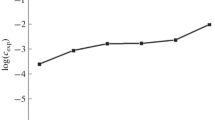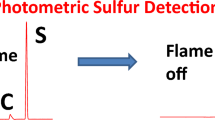Summary
A new flame-photometric method of determination, the Double-Coefficient Method, based upon the standard-addition technique has been proposed.
The method is found to be useful for samples where a concomitant may seriously interfere with the radiation intensity of the specified substance. No knowledge about sample composition is needed and the only prerequisite to the method is the log-log translation rule which has been generally valid when alkali metals are specified and concomitants cause multiplicative interference. In other words, the method is generally applicable where the “concomitant” C−I curve is expressed in a formI * = n· f(m·c) in which I* is the intensity recorded,C is the concentration of specified substance,I = f(C) is the expression for the “specified”C- I curve andm andn are constants which need not be known.
Many determinations of NaCl have been carried out with various interfering concomitants. In only exceptional cases did the relative error exceed 10% no matter how much interference there was from concomitants.
It is suggested that some investigation into the dependence of the logC− logI relation on various excitation conditions, and some method of controlling theC-I function would be of great interest and practical value. In some special case the Double-Coefficient Method needs only a very simplified procedure.
Zusammenfassung
Eine neue flammenphotometrische Bestimmungsmethode wird vorgeschlagen. Diese „Doppel-Koeffizient-Methode“ beruht auf der Zugabe von Standard-Substanzen und erwies sich als geeignet für Proben, in denen eine Begleitsubstanz die Strahlungsintensität des zu bestimmenden Elementes wesentlich beeinflußt. Keinerlei Kenntnis der Zusammensetzung der Probe ist nötig. Die einzige Vorbedingung des Verfahrens ist das „Gesetz der log-log-Übertragung“, das allgemein für die Bestimmung von Alkalimetallen neben multiplikativ störenden Begleitsubstanzen gültig ist. Mit anderen Worten, die Methode ist allgemein dort anwendbar, wo dieC-I-Kurve der Begleitstoffe durch die BeziehungI * =n · f(m·.C) ausdrückbar ist; darin steht I* für die beobachtete Intensität,C für die Konzentration des zu bestimmenden Elementes,I = f(C) gilt für dieC-I-Kurve des zu bestimmen- den Elementes, m undn stellen Konstanten dar, deren Wert nicht bekannt zu sein braucht.
Zahlreiche Bestimmungen von NaCl wurden neben verschiedenen störenden Begleitstoffen ausgeführt. Nur in Ausnahmefällen und unabhängig von dem Ausmaß deren störender Wirkung überschritt der Fehler 10%.
Die Untersuchung der Abhängigkeit des logC - logI-Verhältnisses unter verschiedenen Anregungsbedingungen sowie eine Überprüfung derC- I-Funktion wäre von großem Interesse und praktischem Wert. In einzelnen, besonders gelagerten Fällen bedarf die „Doppel-Koeffizient-Methode“ nur einer sehr vereinfachten Arbeitsweise.
Résumé
On a proposé une nouvelle méthode de dosage par photométrie de flamme, la méthode du double coefficient, fondée sur la technique d'addition d'un échantillon-type. On a trouvé que cette méthode était utile pour l'analyse des échantillons dans lesquels la présence d'une substance concomitante était susceptible d'altérer de façon importante l'intensité de radiation de la substance étudiée. Il n'est pas nécessaire de connaître la composition de l'échantillon, il suffit de connaître au préalable la règle de translation log-log qui est généralement valable lorsque la substance étudiée est un métal alcalin et que les substances concomitantes donnent lieu à des erreurs multiples. En d'autres termes, la méthode est généralement applicable lorsque la courbeC-I de la substance “concomitante” s'exprime sous la forme I* =n · f(m·.C) dans laquelle I* est l'intensité enregistrée,C est la concentration de la substance étudiée,I = f(C) est l'expression de la courbeC-I pour la substance étudiée etm etn des constantes qu'il n'est pas necessaire de connaître.
De nombreuses déterminations de NaCl ont été effectuées en présence de diverses substances concomitantes gênantes. Ce n'est que dans des cas exceptionnels que l'erreur relative s'est élevée au-dessus de 10%, indépendamment de l'importance des perturbations apportées par les substances concomitantes.
On propose de rechercher l'influence de certaines conditions d'excitation sur la relation logC-logI et d'établir une méthode de contrôle de la fonctionC-I, qui seraient d'une grande valeur pratique. Dans quelques cas particuliers la méthode du double coefficient ne nécessite qu'une technique très simplifiée.
Similar content being viewed by others
References
S. Fukushima, M. Shigemoto, I. Kato, andK. Otozai, Mikrochim. Acta [Wien]1957, 35.
S. Fukushima, K. Takahashi, S. Terasaka, andK. Otozai, Mikrochim. Acta [Wien]1957, 183.
C. G. James andT. M. Sugden, Nature171, 428 (1953).
Author information
Authors and Affiliations
Rights and permissions
About this article
Cite this article
Fukushima, S., Yukawa, K., Shigemoto, M. et al. Another new application of standard-addition technique in flame spectrophotometry. Mikrochim Acta 46, 553–570 (1958). https://doi.org/10.1007/BF01247231
Received:
Published:
Issue Date:
DOI: https://doi.org/10.1007/BF01247231




